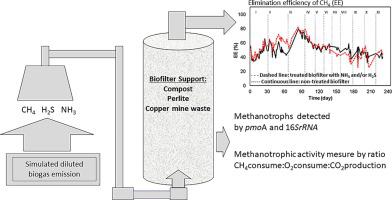Chemical Engineering Journal ( IF 15.1 ) Pub Date : 2023-06-01 , DOI: 10.1016/j.cej.2023.143704 Daniel Valenzuela-Heredia, Germán Aroca

|
Fugitive methane emissions impair the physical and chemical stability of the atmosphere. Biological systems, such as biofilters, have been proposed as a feasible technology for the abatement of CH4 in diluted emissions (<5% [CH4]). Other gases, such as NH3 and H2S, are also present in these emissions; and they could be detrimental for the performance of biological CH4 abatement strategies. The objective of this work was to establish the magnitude of the impact on the biofiltration of CH4 due to the presence of NH3 and H2S.
A methane biofiltration system operating at load of 10 gCH4m-3h−1 was affected by the presence of NH3 and H2S in a synthetic diffuse stream, where the elimination capacity (5.5 gCH4m-3h−1) and efficiency (55%) varied significantly. A combination of 100 ppmv of NH3 and 100 ppmv of H2S decreased the capacity by 17% with respect to the unexposed biofilter while 500 ppmv of NH3 and 300 ppmv of H2S shrink the capacity by 26%. Separately, H2S decreased the methane elimination capacity by 11% under 150 ppmv and 20% when 300 ppmv was supplied. In the case of NH3, the presence of 100 ppmv and 300 ppmv of NH3 increases the methane elimination capacity by 35% and 16%, respectively. A reduction of 32% in the elimination capacity was observed under 1000 ppmv of NH3. We contribute with numerical evidence by which methane biofiltration was affected by secondary gases on a concentration range similar to those in waste methane diffuse stream, establishing the concentration ranges of H2S and NH3 at which it is possible to optimize the process of methane biofiltration and under which performance could be reduced.
中文翻译:

用于处理含有氨和硫化氢的模拟稀释沼气排放物的甲烷生物过滤
逸散性甲烷排放会损害大气的物理和化学稳定性。生物系统,例如生物过滤器,已被提议作为减少稀释排放物(<5% [CH 4 ])中的 CH 4的可行技术。这些排放物中还存在其他气体,例如 NH 3和 H 2 S;并且它们可能不利于生物 CH 4减排策略的性能。这项工作的目的是确定由于 NH 3和 H 2 S的存在对 CH 4生物过滤的影响程度。
在 10 gCH 4 m -3 h -1负荷下运行的甲烷生物过滤系统受到合成扩散流中NH 3和 H 2 S 的影响,其中消除能力 (5.5 gCH 4 m -3 h -1 )和效率 (55%) 差异很大。100 ppmv 的 NH 3和 100 ppmv 的 H 2 S的组合使未暴露的生物过滤器的容量减少了 17%,而 500 ppmv 的 NH 3和 300 ppmv 的 H 2 S 使容量减少了 26%。分别地,H 2S 使甲烷消除能力在 150 ppmv 下降低了 11%,在提供 300 ppmv 时降低了 20%。在 NH 3的情况下,100 ppmv 和 300 ppmv 的 NH 3的存在分别使甲烷消除能力增加了 35% 和 16%。在 1000 ppmv 的 NH 3下观察到消除能力降低了 32% 。我们贡献了数值证据,表明甲烷生物过滤受到二次气体的影响,二次气体的浓度范围与废弃甲烷扩散流中的浓度范围相似,确定了可以优化甲烷生物过滤过程的H 2 S 和 NH 3的浓度范围并且性能可能会降低。

























 京公网安备 11010802027423号
京公网安备 11010802027423号